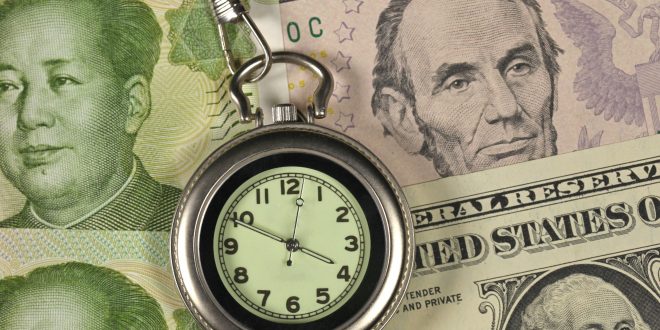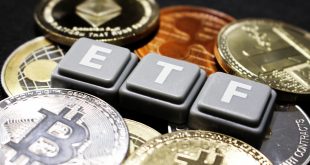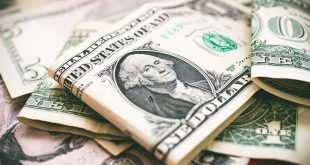Last week, as China seeks to intensify its efforts to reduce stubborn financial risks and technological bottlenecks during President Xi Jinping’s third term, the country kept the top leaders at the central bank and the Ministry of Finance unchanged.
In the United States, a government study on Friday renewed hopes of reducing inflation amid signs that the pandemic-disrupted labour market is normalizing, meaning the US Fed may not need to hike interest rates as sharply as some had previously anticipated.
After the US jobs report on Friday, the US dollar fell significantly. Following Jerome Powell’s aggressive comments at the Fed, the DXY reversed all of the gains. The US economy added more jobs than expected (311K vs. 205K) in February, confirming the startling January results. Both wage growth and the unemployment rate slowed, rising to 4.6%. Before NFP, expectations about a 50 basis points rate hike at the next FOMC meeting were elevated and then pulled back, pushing US yields to the downside. With aversion to risk, Treasury bonds also increased.
On Friday, the VIX (Fear index) surged to a level not seen since late October, reaching 27.42. The US market indices continued to fall on Friday, finishing the week down more than 4%.
As the FOMC enters the blackout period, there won’t be much Fed chatter the next week. Before the meeting on March 21–22, there will be plenty of time for rumours and speculation. Experts predict different things; some predict a 25 bps increase and others a 50 bps increase.
German consumer prices rose by an annual 9.3% in February, confirming preliminary data, while Spanish retail sales rose 5.5% in January, topping last month’s growth. Germany’s DAX (.GDAXI) fell 1.3% and Spain’s IBEX (.IBEX) was down 1.5%.
Oil, Natural Gas
Oil fell for a fourth session on Friday, heading for its biggest weekly loss in five weeks on worries about the prospect of looming interest rate hikes in the United States slowing economic growth and hitting fuel demand. Brent dipped 39 cents, or 0.5%, to $81.20 a barrel. WTI crude was down 58 cents, or 0.8%, at $75.14. Expectations of further rate hikes in the world’s largest economy as well as in Europe clouded the global growth outlook and drove both crude benchmarks down more than 5% so far this week, their worst drop since early February.
In the US, Fed Chair Jerome Powell warned of higher and potentially faster rate hikes, saying the Fed was wrong in initially thinking inflation was “transitory” and was surprised by the strength of the labour market.
Since their peak on March 8, 2022, oil prices have fallen by 40% in a year when adjusted for inflation. Oil prices are falling as a result of rate increases and worries about a possible slowdown in the American economy. Many significant oil traders anticipate that crude prices will gradually return to $100 in the second half of 2023, despite concerns about rising interest rates.
A mostly mild start to March continued to pressure natural gas price during the March 6-10 trading week. Led by massive declines on the West and East coasts, NGI’s Weekly Spot Gas National Avg. dropped 52.0 cents to $3.015/MMBtu for the March 6-10 trading period.
Natural gas futures didn’t fare any better, in fact, only worse. Only one short week from touching $3.00/MMBtu, the April Nymex gas futures contract closed out the week at $2.430. With temperatures soaring into the 80s in Texas and the only chilly weather in the western and northern states, gas demand was moderate at best. Price action reflected the decline in significant heating loads across the country, with the biggest losses for the week occurring out West.
Major Central Banks
The effect on interest rate estimates has been significantly decreased, with a terminal rate of 5.283%. Until next week’s inflation data indicates elevated pressures, the discussion over whether the Fed will choose a 25bps or 50bps increase is now leaning towards the former.
Since the high interest rate environment (tight monetary policy) is beginning to reveal the fragilities in some sectors of the global financial markets, it is important to bring up the issue of the banking sector’s distress following the Silicon Valley Bank (SVB) shutdown by regulators. This may lead the Fed to act cautiously.
The European Central Bank is anticipated to increase its base interest rate at its meeting the following week by an additional 50 basis points, bringing it to its highest level since the introduction of the euro.
Prior to the monetary policy meeting, ECB President Christine Lagarde, who has previously stated that she is watching wages “very, very closely,” warned that the central banks needed to do more to combat the “monster” of inflation. The central bank would “very, very likely” proceed with a half percentage point increase on March 16 despite the possibility that overall inflation may decline even while headline inflation may.
After four rises of 75 basis points last year (0.75 percentage points), the Fed slowed the rate rise to 50 basis points in December and then to 25 basis points at its last meeting. But his remarks yesterday indicate the Fed is set for a 50-basis point rise after its next policy-making meeting on March 21-22.
As anticipated, the Bank of Canada held its interest rate at 4.50% on Wednesday, making it the first significant central bank to halt its monetary tightening campaign in response to an anticipated decline in high inflation. In order to control inflation, which peaked at an annualized rate of 8.1% last year and eased to 5.9% in January but is still close to three times the Bank of Canada’s 2% target, the Canadian central bank raised rates eight times in a row by a total of 425 basis points during the past year.
At his final policy meeting on Friday, the outgoing governor of BoJ, Haruhiko Kuroda, maintained the Bank of Japan’s ultra-dovish monetary policy position. Broadly in line with predictions, the Bank of Japan maintained its negative interest rate at -0.1% and reaffirmed the goal of the central bank to keep the yield on the 10-year Japanese Government Bond (JGB) at or below 0%.
For the past ten years, Kuroda has overseen the central bank’s ultra-dovish monetary policy, even while other central banks across the world recently increased interest rates in an effort to rein in inflation.
Commodities, Gold
Analysts attribute the steep decline in global lithium prices since mid-November to lower EV demand in China and higher car inventory. A large portion of the gains from the rally in the underlying metal that started in 2021 have so far been safeguarded by the shares of some lithium producers. The share price of Pilbara Mines had an extraordinary 20-fold increase over that time and is still not quite at its top.
Gold prices closed considerably higher last week after a wild surge thanks to US NFP data. Instead of focusing on the headline NFP announcement, the markets focused on the increased unemployment and dropping wage data. Due to the mixed jobs data, the upcoming US CPI report will receive more attention. By virtue of the lengthy lower wick from the previous week, which gives bulls room to continue the recent upside surge, the weekly gold chart may be suggestive of a bullish extension of the current advance.
Forex In A week
The Dollar Index reached its highest point since November near its peak of 106.00 before falling all the way to 104.50. The US 2-year Treasury yield increased to its highest level since 2007 at 5.08% before dropping to its lowest level in three weeks on Friday at 4.58%. The Dollar maintained weekly gains against currencies of emerging markets and commodities despite the DXY’s reversal.
After failing to stabilize above 137.00 due to falling bond rates and the sell-off on Wall Street, USD/JPY fell for the second week in a row. The Bank of Japan kept its policy rate, the parameters for the Yield Curve Regulation, and its guidance constant at its most recent meeting under Kuroda.
The Swiss Franc was one of the best-performing currencies this week, helped by risk aversion, falling rates, and Swiss inflation figures. Since November, USD/CHF lost the most money weekly. The Australian Dollar was the biggest loser on G10 space affecter after the Reserve Bank of Australia’s dovish rate hike.
Throughout the course of the week, USD/CAD increased by more than 200 pip, closing above 1.3800, the second-highest weekly finish since May 2020. On Wednesday, the Bank of Canada held rates unchanged (as predicted) after eight consecutive raises and stated it will stay on “a conditional pause”. In February, the Canadian economy created 21.8K more jobs than analysts had predicted.
EUR/USD erased weekly losses rising back toward 1.0650 on Friday. The pair continues to move sideways between 1.0530 and 1.0700. Next Thursday, the European Central Bank is expected to hike interest rates by 50 basis points. Some debate is emerging at the board about its forward guidance. EUR/GBP is still clinging to the 0.8850 area. GBP/USD rebounded from 1.1800, peaked at 1.2115, to settle around 1.2040. UK employment data is due on Tuesday.
Stocks
European stock markets closed flat Monday, after paring modest early-session gains. Markets had a positive opening following last week’s boost before slipping into the red. The pan-European Stoxx 600 provisionally closed down 0.03%. Mining stocks dropped 2.6% to lead losses, with Anglo American and Rio Tinto among the worst performers.
China’s announcement of a growth target of 5% this year after it fell short of its “around 5.5%” target in 2022, could feel disappointing to some investors. Sector gains on Monday were led by travel and leisure stocks, which were up 1.8%.
Stocks in Asia-Pacific were mixed as investors further digested comments on the Chinese economy outlined in its parliamentary sessions. US stocks were higher in early trade as Wall Street looked ahead to a week filled with economic data and the latest commentary from the Fed.
European shares slid to a seven-week low on Friday as financial stocks led a broader market rout after a warning from a US bank triggered worries over the sector’s balance sheet resilience in the face of rising interest rates.
The pan-European STOXX 600 index closed 1.4% lower on Friday, and the week down 2.3%, its steepest weekly fall so far this year. Banks fell 3.8%, the biggest one-day fall in nine months, as HSBC, Deutsche Bank, Barclays, Unicredit and Commerzbank dropped between 2.6% and 7.4%. Credit Suisse’s shares hit a new record low and the financial services index (.SXFP) dropped 2.8%.
The sell-off was sparked by US tech specialist Silicon Valley Bank’s failed scramble for fresh capital, after losing $1.8 billion selling a package of bonds to meet depositor demands for cash. European banks are groaning under the weight of worry about how much value their large bond holdings will have dropped by.
The Week Ahead
Tuesday’s release of the US Consumer Price Index will be the major economic report that could put an end to the discussion. These figures would be crucial in determining whether the Fed should raise interest rates. On Wednesday, the Produce Price Index and Retail Sales will both be released, providing additional inflation data.
Australia will release employment data on Thursday. The important 0.6600 support level was broken, and the AUD/USD fell to its lowest level since November. Selling AUD/CHF following the RBA meeting was one of the finest trades of the week.

 Noor Trends News, Technical Analysis, Educational Tools and Recommendations
Noor Trends News, Technical Analysis, Educational Tools and Recommendations




